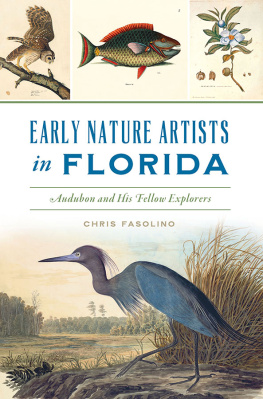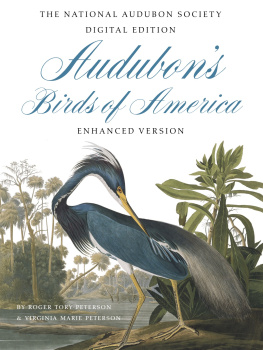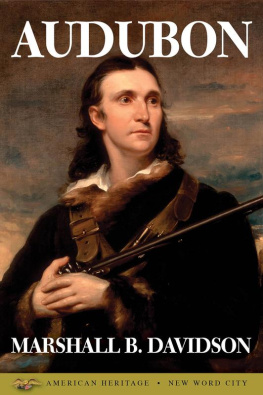
AUDUBONS WESTERN JOURNAL
1849-1850
Being the MS record of a trip from New York to Texas, and an overland journey through Mexico and Arizona to the gold-fields of California
BY
JOHN W. AUDUBON
With biographical memoir by his daughter
MARIA R. AUDUBON
Introduction and notes by FRANK HEYWOOD HODDER
Professor of American History, University of Kansas
1906
2014 Get more great reading from BIG BYTE BOOKS
Get your FREE EBOOK join our mailing list to get notified of great new (old) books and the latest blog posts.
BIG BYTE BOOKS is your source for great lost history!
INTRODUCTION
ORDINARILY events are the result of antecedent causes, but now and then an apparently fortuitous incident upsets all calculations and changes the course of history in a day. Of such a character was the discovery of gold in California. It would be difficult to overstate its importance. It led directly to a similar discovery in Australia and the combined output of the two fields replenished the worlds stock of precious metals, shaped monetary systems, stimulated prices and powerfully affected the economic and industrial development of the last half century. Politically for the United States the discovery was the turning point in the struggle between the sections. Texas had been annexed and the South West wrung from Mexico largely for the purpose of equalizing slave and free territory by providing the South with an outlet for Western emigration comparable in extent with that possessed by the North. The instantaneous settlement of California under circumstances unfavorable to slavery produced a free state and gave the North a majority in the Senate. The attempt to recover the lost ground brought on the Kansas struggle and precipitated the war that destroyed the only real cause of antagonism between the sections. Socially the results of the discovery were not less important.
Immediately a new state was added to the Union. Ultimately the necessity of joining the new state to the older ones opened the West to settlement, built the trans-continental railways, reclaimed the desert and peopled the continent. Fifty years ago Congress was petitioned to import thirty camels and twenty dromedaries and their use as a means of crossing the Western deserts was seriously discussed in books and newspapers. Today there is no part of this vast territory that is not within easy reach of the railroad. Of the remarkable things accomplished in the United States perhaps the most remarkable is the rapid movement of population from seaboard to seaboard, and yet this movement has been strangely neglected by historians. They follow minutely the course of Coronado and Radisson but know little of J. S. Smith and scarcely take the trouble to trace the routes of even so famous an explorer as John C. Fremont. They devote much space to the difficulties of settling Jamestown and Plymouth and very little to the hardships of the overland journey. They carefully trace the campaigns of the War of 1812 but barely mention the wars that have won the continent from the Indians. As throwing a side-light upon one phase of this neglected movement Audubons Journal is presented to the public. But quite apart from this, the book is interesting as a human document. Not only does it reflect the energy and strength of character of the author but the glimpse it gives of the constancy of the greater part of his companions and of mans humanity to man under the most trying circumstances strengthens faith in the essential soundness of human nature.
The Californian discovery was made in January of 1848. Wildly exaggerated rumors of what had been found reached the Eastern states by the middle of the following September. Official reports were received in Washington in time for mention in the Presidents annual message of December 5. The rush to California had already begun. As the continent could not be crossed in the winter, the earliest to start went by water. Large numbers embarked upon the long and dreary voyage around the Horn or rushed to Panama and Nicaragua to take ship from the Pacific seaports. As the spring opened, crowds collected at Independence, Missouri, ready to begin the overland journey in May, which was as early as it was safe to start. There were two overland routes from this point. The northern one followed the Oregon Trail to Fort Hall and from there crossed by way of the Humboldt River and over the Sierra Nevadas to California. The southern route followed the Santa Fe Trail to Santa Fe, where the emigrants divided, a part taking the Old Spanish Trail to the north and a part General Kearnys route along the Gila on the south. While some of the emigrants went as individuals, by far the larger number went in companies. Stock was subscribed to meet expenses, often by men who did not go in person, and the companies were organized for mutual assistance and defense. The company which Mr. Audubon joined was financed by his friends, the Kingslands, and was to be led by Col. Henry L. Webb. Colonel Webb, a New Yorker by birth, had joined the volunteers from Illinois at the outbreak of the Mexican war, and later had been promoted to the command of a regiment. Having served in Mexico, he knew something of the country. Partly for this reason but chiefly no doubt in order to get an earlier start, the company was to take the Mexican route. The wisdom of the choice might have been vindicated but for the loss of life and the delay caused by the cholera. This scourge was not, however, confined to the southern routes. Carried up by the river boats to Independence, it attacked the emigrants before leaving on their journey and, pursuing them to the mountains, lined the roads across the plains with newly made graves.
Leaving New York, February 8, 1849, with about eighty men and a capital of $27,000, Mr. Audubon proceeded by water to Philadelphia and Baltimore, took the railroad to Cumberland and thence crossed the Alleghanies by stage to Brownsville and Pittsburg. Here the company took a river boat for Cairo, where they were joined by Colonel Webb. Changing boats they descended the Mississippi to New Orleans, which they reached February 18, ten days after leaving New York. After some time spent here in the purchase of supplies, they took a boat for Brazos at the mouth of the Rio Grande. From Brazos they were carried up the Rio Grande to a point opposite Rio Grande City, where they landed on the tenth of March. Here they were attacked by the cholera and ten men succumbed to the dread disease. To add to their distress, the companys money was stolen and only after great difficulty was a part of it recovered. Discouraged by disease and misfortune, twenty of the men turned back. Then Colonel Webb deserted his company, the men at the same time refusing to go on under his leadership. For a time it seemed that the journey would be abandoned but about half of the men asked Mr. Audubon to lead them and bound themselves to go on under his command. More than a month was required for reorganization and for the recovery of the sick, so that it was not until April 28 that the start was really made. They were now as late as the emigrants who started by the northern routes, and were further from their goal.
Leaving the Rio Grande at Roma, the company took the main road to Chihuahua, passing through Monterey, Saltillo, Buena Vista, Parras, and Mapimi and reaching Parral June 18. Cholera still followed them and here claimed another victim. Mr. Audubon had been twice attacked but had been able to resist the disease. At Parral the company left the highway and struck across the mountains to Sonora. On the western slope towns were few and far between. Ures was reached August 22 and Altar September 9. Leaving Altar they entered a desert inhabited only by Indians living on lizards and grasshoppers. At the Pima villages on the Gila they reached the line of General Kearnys march, which had become the southern emigrant route. The march through the Gila valley to the Colorado proved the most trying part of the journey. With supplies for the men exhausted, without grass for the mules, and with little water for either, the limit of endurance was almost reached. Crossing the Colorado, the company turned northward through the desert to the mountain passes and then southward to San Diego, whence they followed the trail to Los Angeles. Here Mr. Audubon decided to send the greater part of the company to San Francisco by sea, while he, with ten of the men, drove the mules through by land. Crossing the coast range the route now followed the Tulare valley and the San Joaquin
Next page








